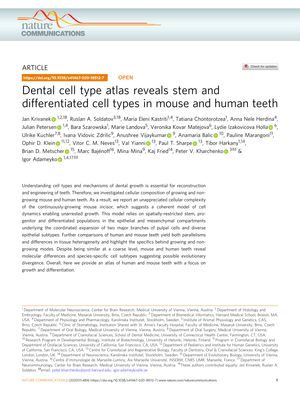Dental cell type atlas reveals stem and differentiated cell types in mouse and human teeth
September 2020
in “Nature Communications”

TLDR The research identified various cell types in mouse and human teeth, which could help in developing dental regenerative treatments.
The document presents a detailed study of the cellular composition of mouse and human teeth, using single-cell RNA sequencing to map a wide variety of stem and differentiated cell types involved in tooth development and regeneration. The study analyzed 2,889 single cells from mouse incisors, identifying 17 distinct cell clusters, and profiled 39,095 cells from human teeth, revealing analogous cell types to those in mice, as well as species-specific differences. The research provided insights into the cellular mechanisms underlying continuous growth in mouse incisors and the complexity of human dental tissues, with implications for dental tissue engineering and regenerative medicine. The study involved a significant number of samples, including 78 mouse incisors, 48 mouse molars, 7 human wisdom molars, and 6 apical papillae, providing a robust dataset for understanding tooth biology.
View this study on nature.com →
Cited in this study

research Macrophages Promote Wound-Induced Hair Follicle Regeneration in a CX3CR1- and TGF-β1–Dependent Manner
Macrophages help hair growth after injury through CX3CR1 and TGF-β1.